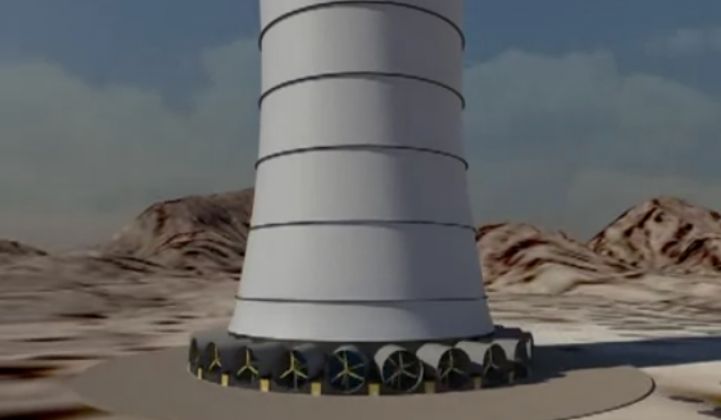Imagine a tower as tall as two Empire State Buildings that can produce as much energy as the Hoover Dam at a price competitive with natural gas.
That's what the startup Solar Wind Energy Tower is selling. Is it for real?
If the experience of EnviroMission, another penny-stock company, is any indication, then likely not.
This spring, Solar Wind Energy Tower (SWET) secured an agreement with the town of San Luis, Arizona, located on the Mexico border, to build the $1.5 billion project. If ever completed, it would become the tallest structure in North America and the second tallest structure in the world after the Burj Khalifa.
The technology works by spraying water at the top of a 2,250-foot-high, 500-foot-wide hollow tower, located in a hot, dry climate. As the water saturates the solar-heated air, it evaporates, cools and falls. The air accelerates as it sinks through the tower, creating 50 mile-per-hour winds that exit at the base through a series of tunnels. The rushing winds drive electricity-generating turbines.
“The Tower is designed to produce approximately 4,000,000 megawatt-hours annually,” said Ronald Pickett, chairman and CEO of SWET. “That’s slightly more than the Hoover Dam has averaged per year over the past ten years.”
The physics of the energy tower are sound. Phillip Carlson developed the concept for the so-called downdraft energy tower in 1975. Researchers at Israel’s Technion expanded on the idea in 2001.
In the 1980s, engineers built a prototype in Spain to power a manufacturing facility. The project generated electricity, but was never commercially viable for selling power to the grid. It eventually toppled during a storm after about a decade of operation.
Pickett claims SWET's proposed technology is smaller and less expensive than Technion's 4,000-foot design. He said the project will also benefit from years of site-specific weather data to improve performance.
SWET estimates that operating the tower will require roughly 8,000 acre-feet of water per year. That's less water than is needed to irrigate and farm 1,000 acres, but it's still a lot of water to find in the desert. According to Pickett, the City of San Luis has included a 50-year water supply agreement to meet the tower's needs.
SWET has also procured a site and a water supply to build a second tower near the sister city of San Luis, Mexico. The company hopes to break ground on one of the two projects by the end of next year, with completion slated for 2018.
Factors such as siting the project, developing a computer model to predict the conditions, finding a financier, lining up contractors and getting all of the other pieces in place “are monumental tasks” for a small company, said Pickett. “The market doesn’t reflect the kind of success we are currently enjoying, but we are doing it…and we’re very pleased with our progress.”
Roadblocks ahead
But the permitting and bankability of SWET’s technology, due to the sheer size and novelty of the project, may ultimately doom it.
SWET announced preliminary funding from National Standard Finance, a large international infrastructure fund, but has not finalized any specific agreement. It also still needs to secure long-term power-purchase agreements (PPAs), which was a point of failure for EnviroMission's project in Arizona.
Pickett said his company is in PPA negotiations with California utilities, but it isn’t ready to release any further details. The technology has been certified by the California Energy Commission as a suitable alternative energy resource, and so it can generate renewable energy certificates.
“We’re prepared to develop the project. We’ve got preliminary financing commitments. We have contractors lined up, everything,” he said. “All we need are the PPAs.”
Without them, the project goes nowhere.
In the meantime, SWET needs more money and a development partner. To date, it has raised capital through its penny stock public company.
The public company’s business model is to license its patented energy tower technology to places in the Middle East and other desert regions around the world. They're hoping that once the first tower is built, other investors will want to build their own.
“If a utility were to take on this project, license it from us and develop it themselves -- which I am sure they will after they see the first one up and operational -- they will be able to make power as inexpensively as they make power if they were using natural gas, and save the natural gas,” said Pickett.
But there are doubts. SWET stated in its own Securities and Exchange filing from March: “Our independent auditors have expressed substantial doubt about our ability to continue as a going concern, which may hinder our ability to obtain future financing.”
According to its latest 10-Q report, SWET hasn’t generated any revenue since its inception and is burning through an increasing amount of cash. Through the first nine months of 2014, the company's research and development costs were $92,705, compared to $37,873 for the same period last year.
Administrative expenses are also up 6 percent, from $1,367,878 during the first nine months of this year, compared to $1,288,101 for the same period last year. As of September 30, 2014, the company’s working capital deficit reached $3,251,904.
According to Bloomberg Businessweek, Pickett made $200,000 last year. SWET’s Chief Operating Officer Stephen Sadle made $175,000. SWET currently has three full-time employees.
At this point, the company’s most successful endeavor has been to tell a good story.



